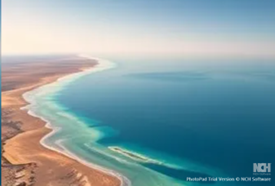nCa-AI Collaborative Report
Once a symbol of ecological disaster, the Aral Sea is witnessing a remarkable recovery, thanks to the concerted efforts of Central Asian nations and international partners. Recent developments highlight significant progress in restoring the Northern Aral Sea, offering hope for environmental recovery, economic revitalization, and improved quality of life for local communities.
Resurgence of Water Levels
The water volume of the Northern Aral Sea, located off the coast of Kazakhstan, has surged by 42% to 27 billion cubic meters—a monumental achievement compared to its critically low levels just a few years ago. According to Kazakhstan’s Ministry of Water Resources and Irrigation, this increase reflects systematic conservation efforts over the past two years.
Between October 2024 and January 2025 alone, one billion cubic meters of water were directed into the sea—100 million cubic meters more than initially planned. By March 2025, an additional influx of water is expected to bring the total to 1.6 billion cubic meters, thanks to agreements with neighboring Central Asian countries. These collaborative measures have not only stabilized water levels but also expanded the sea’s surface area to 3,065 square kilometers, marking an increase of 111 square kilometers since 2022.
Ecological Recovery and Economic Benefits
The resurgence of water levels has had profound ecological benefits. Salinity levels in the Northern Aral Sea have decreased significantly, creating favorable conditions for native fish species to thrive. The annual fish catch has risen to 8,000 tons, supporting local fisheries and boosting the regional economy. Today, 22 fish species inhabit the sea, signaling a dramatic recovery from the near-collapse of aquatic biodiversity decades ago.
Efforts to restore the Syr Darya River delta and preserve critical infrastructure like the Kokaral Dam are nearing completion. Reconstruction projects on dams between Lake Karashalan and the Syr Darya, along with the construction of protective barriers such as the Tauir dam, have played pivotal roles in stabilizing water flow and reducing salinity. By the end of 2025, the full restoration of the Kokaral Dam is expected to further enhance these gains.
In addition to structural improvements, innovative agricultural practices have contributed to the sea’s revival. In Kazakhstan’s Kyzylorda region, laser leveling technology has been implemented on rice fields, saving approximately 200 million cubic meters of water annually. This saved water has been redirected to the Northern Aral Sea, while simultaneously increasing crop yields from 40-55 centners per hectare to 70-80 centners per hectare. To encourage widespread adoption of such water-saving technologies, the government has raised subsidies for infrastructure installation to 80% and increased compensation for irrigation water costs to up to 85%.
Greening the Aral Basin
Beyond water management, reforestation initiatives are transforming the once-barren landscape of the dried-up seabed. Between 2021 and 2024, 4.4 million seedlings were planted across 475,000 hectares of the Aral Sea basin. An additional 428,000 hectares are slated for greening in 2025, bringing the total afforested area to 1.1 million hectares. These efforts aim to combat desertification, reduce sand and salt storms, and promote soil stability, thereby improving the overall environmental health of the region.
International Leadership and Future Plans
Kazakhstan assumed leadership of the International Fund for Saving the Aral Sea (IFAS) on January 1, 2024, underlining its commitment to regional cooperation. President Kassym-Jomart Tokayev was elected IFAS President for the 2024-2026 term, overseeing a comprehensive work plan that includes approximately 40 initiatives across 10 priority areas. These initiatives focus on enhancing water efficiency, protecting biodiversity, supporting fisheries, and fostering sustainable agriculture—all while creating around 2,000 new jobs.
Nurzhan Nurzhigitov, Kazakhstan’s Minister of Water Resources and Irrigation, emphasized the ultimate goal of these efforts: “to improve the region’s ecology, boost fisheries and tourism, and enhance the quality of life for local communities.” His vision underscores the importance of balancing ecological restoration with socio-economic development.
Lessons from Global Success Stories
The success of the Aral Sea restoration aligns with similar global efforts to rehabilitate degraded ecosystems. For instance:
- In Swindale, England, restoring a river to its natural course revitalized local flora and fauna.
- In Maine, removing restrictive dams restored the Penobscot River, allowing marine wildlife populations to rebound.
- In Colorado, large-scale dam removal projects enhanced river habitats and supported biodiversity.
These examples demonstrate that targeted interventions can yield transformative results, inspiring confidence in the ongoing efforts to save the Aral Sea.
A Beacon of Hope
The Aral Sea’s gradual recovery stands as a testament to what can be achieved through international collaboration, innovative solutions, and sustained commitment. What was once considered an irreversible catastrophe is now a story of resilience and renewal. As Kazakhstan and its partners continue their tireless work, the Northern Aral Sea serves as a beacon of hope—not just for Central Asia, but for the entire world—that even the most daunting environmental challenges can be overcome with determination and unity.
With water levels rising, ecosystems healing, and communities benefiting, the Aral Sea is no longer a cautionary tale but a shining example of humanity’s capacity to heal the planet. /// nCa-AI collaborative, 13 February 2025 (based on material from The Astana Times, The Times of Central Asia and The Cool Down) [Image credit – Flux.1-schnell]
